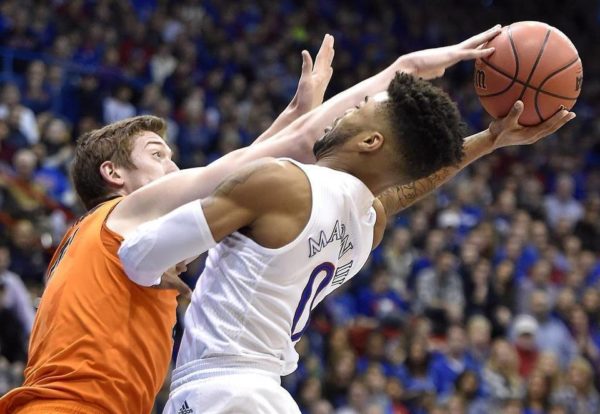Exploring Oklahoma State’s Defensive Woes
Posted by Chris Stone on January 18th, 2017The beginning of Big 12 play hasn’t exactly gone as hoped for Oklahoma State. After jumping out to an impressive 10-2 record in non-conference play under new head coach Brad Underwood, expectations were high for a Cowboys’ team that had only suffered a neutral-site defeat to North Carolina and a one-point loss at Maryland. Through five games of the conference season, however, things couldn’t be going much worse. The trio of defeats to the league’s top three teams — Baylor, Kansas and West Virginia — is understandable, but a pair of losses to Texas and Iowa State are not. What has gone wrong for the Cowboys?

Big man Mitchell Solomon is a major key to Oklahoma State’s defensive success. (Rich Sugg/The Kansas City Star)
The biggest problems have come on the defensive end of the floor where Oklahoma State has allowed opponents to score a league-high 1.18 points per possession (PPP) over those five contests, per KenPom. That figure was a much more reasonable 0.98 PPP during non-conference play, and certainly some of the disparity is attributable to its schedule — the toughest in the league so far. Compare that to a non-conference slate that ranked 120th nationally and it’s easy to understand why Oklahoma State’s four defensive factors — effective field goal percentage, turnover rate, offensive rebounding rate and free throw rate — have been worse across the board.

Two of those statistics — effective field goal percentage and turnover rate — stick out. In Big 12 play, opponents are shooting better against the Cowboys as a result of conversions inside the arc (54.6%). Part of the reason for this has been center Mitchell Solomon‘s inability to stay on the floor. The 6’9″ junior has been a fairly effective rim protector for the Cowboys this season, but he’s played fewer than 50 percent of the available minutes over the last five games because of his astronomical rate of 9.5 fouls per 40 minutes. Senior Leyton Hammonds often slots in as Solomon’s backup and he simply isn’t the same defensive force in the paint. With Solomon spending so much of his time on the bench during conference play, the Cowboys are allowing 1.21 PPP (59.5% 2FG) with him off the floor versus 1.13 PPP (48.2%) while on it, per Hoop Lens.
The Cowboys have also seen a precipitous drop in their defensive turnover rate, forcing a miscue on just 15.8 percent of possessions in conference play. It’s more difficult to trace this issue back to individual players, although point guard Jawun Evans, the team’s leader in steals, has dipped from a steal rate of 3.9 to 1.9 percent in conference play. Given that Oklahoma State’s half-court defense has some similarities to West Virginia’s press, it’s reasonable to theorize that Big 12 teams are more acclimated to playing against this type of pressure and are simply doing a better job in protecting the ball. This is especially likely given the quality of point guards in the league and that this is the Cowboys’ first experience with Underwood’s system.
There are certainly other issues going on too: Oklahoma State’s offense has also lagged in conference play, but not to the same extent that the defense has fallen off. With an inability to protect against high percentage looks inside the arc and to turn opponents over, the Cowboys have struggled to generate enough stops to be competitive in the Big 12. Upcoming games against Kansas State, Texas Tech and TCU should provide an opportunity for Underwood to quickly right the ship, but without an improvement on the defensive end, the rest of the Big 12 season could be rough in Stillwater.









































